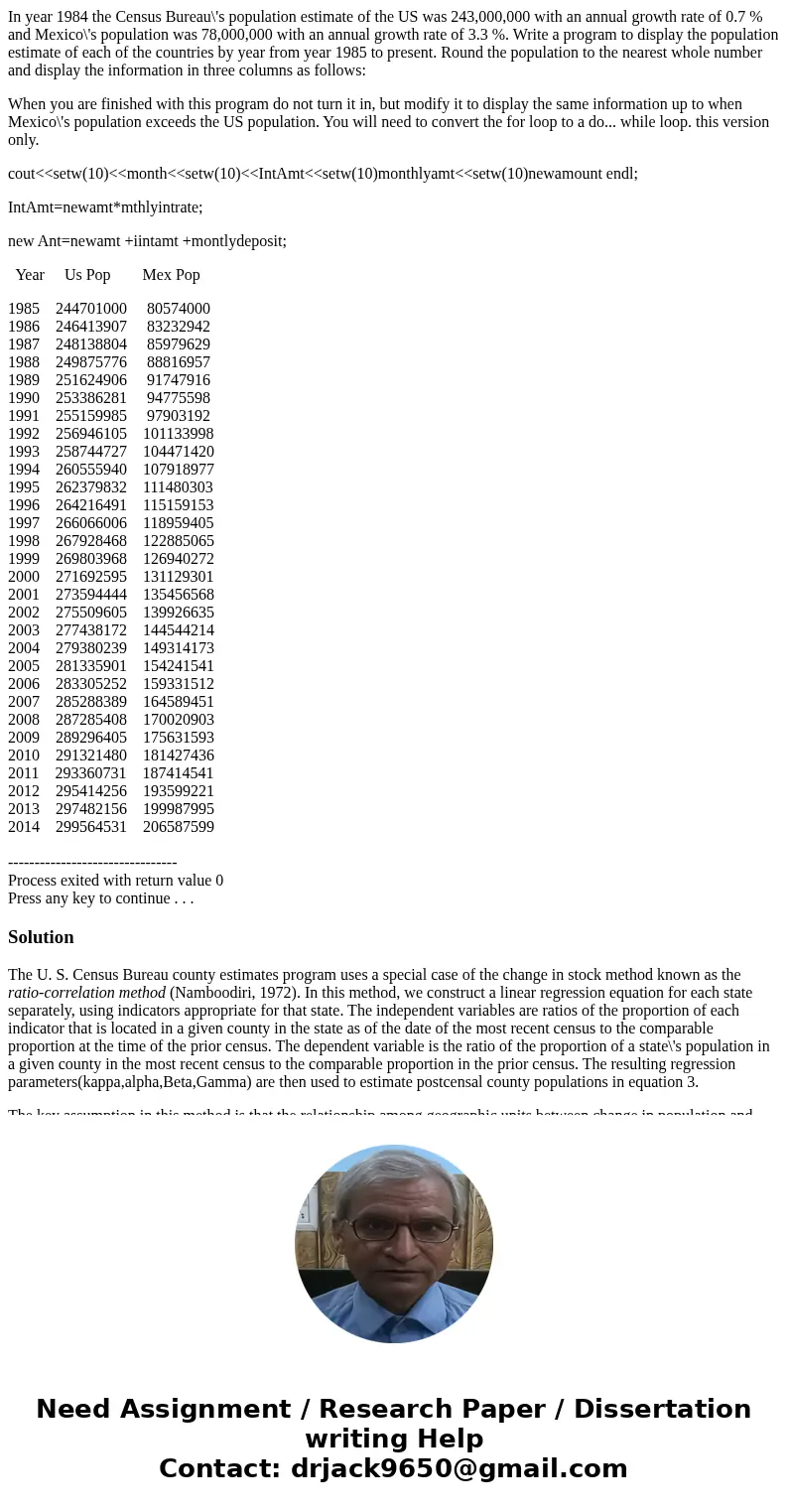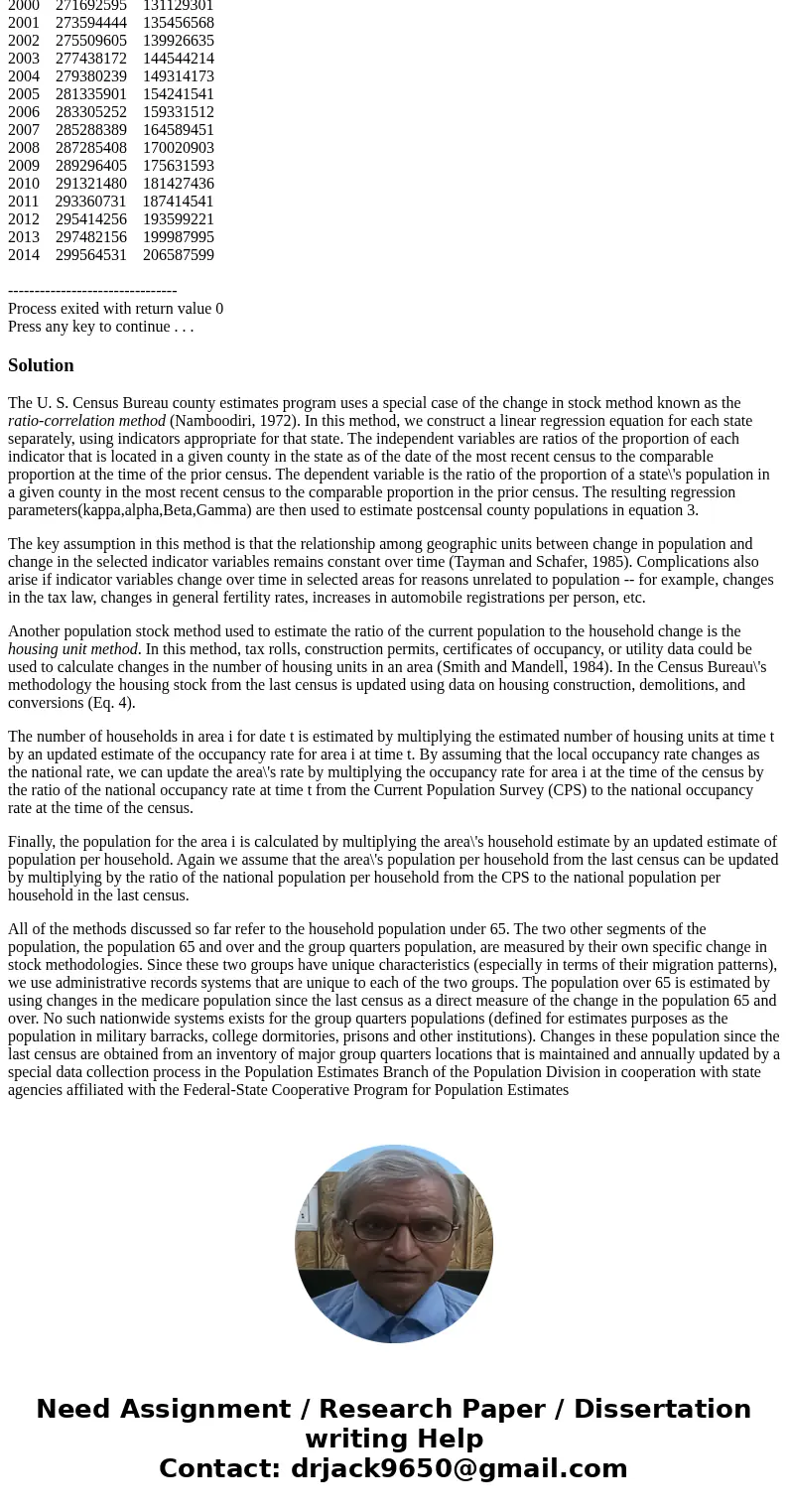In year 1984 the Census Bureaus population estimate of the U
In year 1984 the Census Bureau\'s population estimate of the US was 243,000,000 with an annual growth rate of 0.7 % and Mexico\'s population was 78,000,000 with an annual growth rate of 3.3 %. Write a program to display the population estimate of each of the countries by year from year 1985 to present. Round the population to the nearest whole number and display the information in three columns as follows:
When you are finished with this program do not turn it in, but modify it to display the same information up to when Mexico\'s population exceeds the US population. You will need to convert the for loop to a do... while loop. this version only.
cout<<setw(10)<<month<<setw(10)<<IntAmt<<setw(10)monthlyamt<<setw(10)newamount endl;
IntAmt=newamt*mthlyintrate;
new Ant=newamt +iintamt +montlydeposit;
Year Us Pop Mex Pop
1985 244701000 80574000
1986 246413907 83232942
1987 248138804 85979629
1988 249875776 88816957
1989 251624906 91747916
1990 253386281 94775598
1991 255159985 97903192
1992 256946105 101133998
1993 258744727 104471420
1994 260555940 107918977
1995 262379832 111480303
1996 264216491 115159153
1997 266066006 118959405
1998 267928468 122885065
1999 269803968 126940272
2000 271692595 131129301
2001 273594444 135456568
2002 275509605 139926635
2003 277438172 144544214
2004 279380239 149314173
2005 281335901 154241541
2006 283305252 159331512
2007 285288389 164589451
2008 287285408 170020903
2009 289296405 175631593
2010 291321480 181427436
2011 293360731 187414541
2012 295414256 193599221
2013 297482156 199987995
2014 299564531 206587599
--------------------------------
Process exited with return value 0
Press any key to continue . . .
Solution
The U. S. Census Bureau county estimates program uses a special case of the change in stock method known as the ratio-correlation method (Namboodiri, 1972). In this method, we construct a linear regression equation for each state separately, using indicators appropriate for that state. The independent variables are ratios of the proportion of each indicator that is located in a given county in the state as of the date of the most recent census to the comparable proportion at the time of the prior census. The dependent variable is the ratio of the proportion of a state\'s population in a given county in the most recent census to the comparable proportion in the prior census. The resulting regression parameters(kappa,alpha,Beta,Gamma) are then used to estimate postcensal county populations in equation 3.
The key assumption in this method is that the relationship among geographic units between change in population and change in the selected indicator variables remains constant over time (Tayman and Schafer, 1985). Complications also arise if indicator variables change over time in selected areas for reasons unrelated to population -- for example, changes in the tax law, changes in general fertility rates, increases in automobile registrations per person, etc.
Another population stock method used to estimate the ratio of the current population to the household change is the housing unit method. In this method, tax rolls, construction permits, certificates of occupancy, or utility data could be used to calculate changes in the number of housing units in an area (Smith and Mandell, 1984). In the Census Bureau\'s methodology the housing stock from the last census is updated using data on housing construction, demolitions, and conversions (Eq. 4).
The number of households in area i for date t is estimated by multiplying the estimated number of housing units at time t by an updated estimate of the occupancy rate for area i at time t. By assuming that the local occupancy rate changes as the national rate, we can update the area\'s rate by multiplying the occupancy rate for area i at the time of the census by the ratio of the national occupancy rate at time t from the Current Population Survey (CPS) to the national occupancy rate at the time of the census.
Finally, the population for the area i is calculated by multiplying the area\'s household estimate by an updated estimate of population per household. Again we assume that the area\'s population per household from the last census can be updated by multiplying by the ratio of the national population per household from the CPS to the national population per household in the last census.
All of the methods discussed so far refer to the household population under 65. The two other segments of the population, the population 65 and over and the group quarters population, are measured by their own specific change in stock methodologies. Since these two groups have unique characteristics (especially in terms of their migration patterns), we use administrative records systems that are unique to each of the two groups. The population over 65 is estimated by using changes in the medicare population since the last census as a direct measure of the change in the population 65 and over. No such nationwide systems exists for the group quarters populations (defined for estimates purposes as the population in military barracks, college dormitories, prisons and other institutions). Changes in these population since the last census are obtained from an inventory of major group quarters locations that is maintained and annually updated by a special data collection process in the Population Estimates Branch of the Population Division in cooperation with state agencies affiliated with the Federal-State Cooperative Program for Population Estimates


 Homework Sourse
Homework Sourse